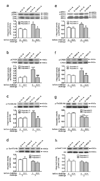D1 and D2 dopamine receptors differentially mediate the activation of phosphoproteins in the striatum of amphetamine-sensitized rats
- PMID: 21057772
- PMCID: PMC3065836
- DOI: 10.1007/s00213-010-2068-4
D1 and D2 dopamine receptors differentially mediate the activation of phosphoproteins in the striatum of amphetamine-sensitized rats
Abstract
Rationale: Extracellular signal-regulated kinase (ERK), cAMP response element binding protein (CREB), and protein kinase B (PKB or Akt) in the striatum are differentially activated by acute and repeated amphetamine (AMPH) administration. However, the dopamine receptor subtypes that mediate transient vs. prolonged phosphorylation changes in these proteins induced by AMPH challenge in AMPH-sensitized rats are unknown.
Objectives: The role of the D1 and D2 class of dopamine receptors in the differential phosphorylation of striatal ERK, CREB, Thr308-Akt and Ser473-Akt and the expression of behavioral sensitization induced by AMPH challenge in AMPH-pretreated rats were determined.
Methods: D1 or D2 dopamine receptor antagonists were injected before an AMPH challenge in AMPH-sensitized rats. After behavioral activity was recorded, rats were euthanized either 15 min or 2 h after AMPH challenge and striatal phosphoprotein status was analyzed by Western blotting.
Results: The D1 receptor antagonist (SCH23390) decreased stereotypical behavior whereas the D2 receptor antagonist (eticlopride) decreased all behavioral activity induced by an AMPH challenge in AMPH-sensitized rats. SCH23390, but not eticlopride, significantly decreased ERK, CREB, and Thr308-Akt phosphorylation in the striatum 15 min, and ERK and CREB phosphorylation 2 h, after AMPH challenge in AMPH-sensitized rats. In contrast, eticlopride, but not SCH23390, prevented a decrease in Akt phosphorylation 2 h after AMPH challenge.
Conclusions: These data indicate that the time course of phosphoprotein signaling is differentially regulated by D1 and D2 receptors in the striatum of AMPH-sensitized rats, suggesting that complex regulatory interactions are activated by repeated AMPH exposure.
Figures




Similar articles
-
Amphetamine elevates phosphorylation of eukaryotic initiation factor 2α (eIF2α) in the rat forebrain via activating dopamine D1 and D2 receptors.Brain Res. 2016 Sep 1;1646:459-466. doi: 10.1016/j.brainres.2016.06.027. Epub 2016 Jun 20. Brain Res. 2016. PMID: 27338925 Free PMC article.
-
Repeated amphetamine treatment increases phosphorylation of extracellular signal-regulated kinase, protein kinase B, and cyclase response element-binding protein in the rat striatum.J Neurochem. 2007 Oct;103(2):706-13. doi: 10.1111/j.1471-4159.2007.04760.x. Epub 2007 Jul 17. J Neurochem. 2007. PMID: 17635666
-
Amphetamine activates non-receptor tyrosine kinase Fyn and stimulates ERK phosphorylation in the rat striatum in vivo.Eur J Pharmacol. 2019 Jan 15;843:45-54. doi: 10.1016/j.ejphar.2018.11.006. Epub 2018 Nov 9. Eur J Pharmacol. 2019. PMID: 30419241 Free PMC article.
-
Regulation of psychostimulant-induced signaling and gene expression in the striatum.J Neurochem. 2008 Mar;104(6):1440-9. doi: 10.1111/j.1471-4159.2008.05240.x. Epub 2008 Jan 21. J Neurochem. 2008. PMID: 18221378 Free PMC article. Review.
-
Interactions between D1 and D2 dopamine receptor family agonists and antagonists: the effects of chronic exposure on behavior and receptor binding in rats and their clinical implications.J Neural Transm (Vienna). 1997;104(4-5):341-62. doi: 10.1007/BF01277656. J Neural Transm (Vienna). 1997. PMID: 9295170 Review.
Cited by
-
RGS4 overexpression in the rat dorsal striatum modulates mGluR5- and amphetamine-mediated behavior and signaling.Psychopharmacology (Berl). 2012 Jun;221(4):621-35. doi: 10.1007/s00213-011-2606-8. Epub 2011 Dec 23. Psychopharmacology (Berl). 2012. PMID: 22193724 Free PMC article.
-
Striatal phosphodiesterase 10A availability is altered secondary to chronic changes in dopamine neurotransmission.EJNMMI Radiopharm Chem. 2017;1(1):3. doi: 10.1186/s41181-016-0005-5. Epub 2016 Mar 21. EJNMMI Radiopharm Chem. 2017. PMID: 29564380 Free PMC article.
-
Hyperactivity and Hypermotivation Associated With Increased Striatal mGluR1 Signaling in a Shank2 Rat Model of Autism.Front Mol Neurosci. 2018 Jun 19;11:107. doi: 10.3389/fnmol.2018.00107. eCollection 2018. Front Mol Neurosci. 2018. PMID: 29970986 Free PMC article.
-
Effects of amphetamine exposure during adolescence on behavior and prelimbic cortex neuron activity in adulthood.Brain Res. 2018 Sep 1;1694:111-120. doi: 10.1016/j.brainres.2018.05.028. Epub 2018 May 21. Brain Res. 2018. PMID: 29792867 Free PMC article.
-
Caudate neuronal recording in freely behaving animals following acute and chronic dose response methylphenidate exposure.Pharmacol Biochem Behav. 2015 Sep;136:21-30. doi: 10.1016/j.pbb.2015.06.003. Epub 2015 Jun 20. Pharmacol Biochem Behav. 2015. PMID: 26101057 Free PMC article.
References
-
- Beaulieu JM, Sotnikova TD, Marion S, Lefkowitz RJ, Gainetdinov RR, Caron MG. An Akt/β-arrestin 2/PP2A signaling complex mediates dopaminergic neurotransmission and behavior. Cell. 2005;122:261–273. - PubMed
Publication types
MeSH terms
Substances
Grants and funding
LinkOut - more resources
Full Text Sources
Miscellaneous

